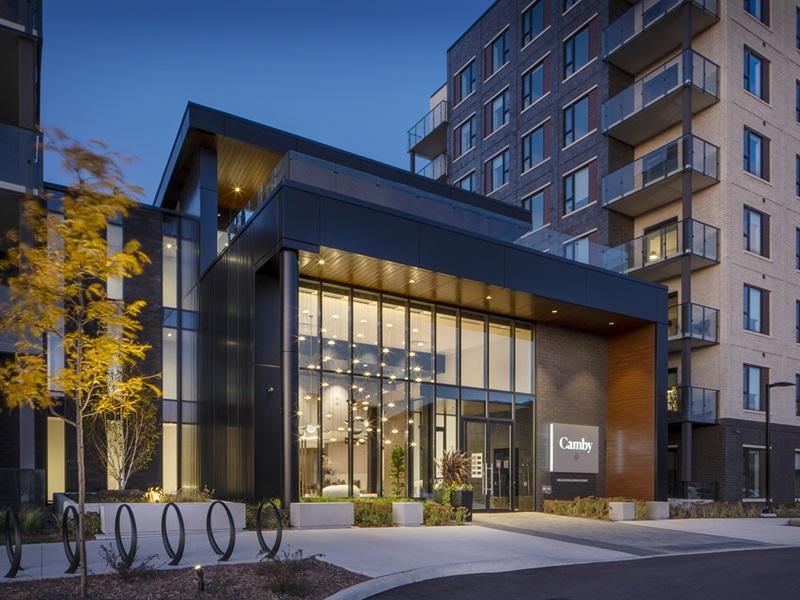
Artist rendering of the Telus Sky Tower in Calgary. (Courtesy TelusSky.com)
The road to recovery for Calgary’s downtown office market will be a long one as the city continues to grapple with historically high vacancy rates in the central business district. Just how difficult it could be is reflected in Avison Young’s latest quarterly report.
With an elevated vacancy rate in the 25 per cent range, there are concerns it could climb even higher this year. The new Telus Sky tower will add to the downtown inventory, combined with fears the province’s struggling oilpatch might experience a new round of layoffs.
Todd Throndson, principal and managing director of Avison Young’s Calgary office, said there continues to be “angst and uncertainty” in the energy sector. Some of that relates to two upcoming elections – the Alberta provincial vote this spring and the federal election in October.
“A lot of them are paying very close attention to; No. 1, hopefully a change provincially (replacing Premier Rachel Notley and the NDP with Jason Kenney and the United Conservative Party); and No. 2, what is this federal government going to do this year with respect to helping the energy sector and the businesses that are aligned with the energy sector?” said Throndson.
“Between the different regulations that Ottawa is looking at which will make it more difficult to get approvals (for pipelines), between the impact that the federal government has now taken in the energy world by taking ownership of the pipeline out to Burnaby, B.C., we need to see some positive steps in 2019 for business to actually start to perceive a positive direction moving forward because right now there’s just a lot of uncertainty. And, quite frankly, a lot of doubt.”
Implications for downtown Calgary
That directly impacts the commercial real estate market in Calgary’s downtown core. Long-time real estate experts in the city will tell you that as the oilpatch goes, so does the downtown office market.
The energy sector in the province was humming along at a great pace until the latter half of 2014 when oil prices collapsed. That led to a recession in 2015 and 2016. Thousands of jobs were shed in the downtown which houses the corporate head offices of the oilpatch giants.
Calgary’s downtown office market had its lowest vacancy rate ever of 0.3 per cent in the third and fourth quarters of 2016.
However, as people left their jobs due to layoffs, empty office space started to pop up throughout the core and the vacancy rate climbed at a rapid pace.
According to Avison Young, it peaked at 26.4 per cent in the second quarter of 2017. In its latest commercial real estate report, the company said the vacancy rate at the end of 2018 was 24.7 per cent, down from 25.2 per cent in the third quarter of the year and from 26 per cent at year-end 2017.
While the downtown market saw positive absorption of 400,000 square feet in 2018 – the first positive change in occupied space in four years – there are concerns vacancy will rise again to peak levels this year. The Telus Sky building will add 460,000 square feet to the overall inventory in Q2 and is only 38 per cent leased.
More potential pain ahead
Avison Young said that alone will drive the vacancy rate downtown to as high as 26.3 per cent.
“Downtown office vacancy could move higher if speculated energy job layoffs actually occur, potentially leading to the highest vacancy rates ever recorded in the city,” says Avison Young’s latest report. “Many oil and gas companies are once again taking a wait-and-see approach regarding office space decisions as they work through their capital plans for 2019 and assess how the political landscape will unfold during the year.
“With both provincial and federal elections set for 2019, many companies are relying on political change to help move the industry forward. It is anticipated that leasing activity in the first half of 2019 will be quite slow.”
Throndson said Avison Young projects negative absorption again this year due to job losses. However, he predicted the cuts won’t be as severe as feared several weeks ago, before the provincial government announced mandatory cuts to oil production in Alberta to improve the price differential of the oil it sells.
How long does he foresee that elevated vacancy rate being part of the downtown landscape?
“We’re not going to see positive absorption again until later next year. I think the bigger question is not how long we’re going to be in the mid-20s (per cent), but how long it’s going to take before we get to 10 per cent which is when you start to affect change in rental rate structure, opportunity structure and those kind of things,” said Throndson.
“That’s going to be a long time. Call it five years. Call it seven years. It is not in the foreseeable future. We are going to continue to have a market with a vacancy challenge for at least five years.”
No new office projects on horizon
In the meantime, Throndson said more work can be done to attract new companies.
“Calgary has a couple of very key parameters that allows it to be on the charts for companies that aren’t here. No. 1, we have cheap real estate. No. 2, we have a highly educated workforce. They’re not educated with the skill sets that a lot of these companies are looking at so they have to consider retraining.
“We have incredible amenities for the younger millennial-type world . . . I think for Calgary to truly affect change in the downtown office market, we have to make sure that we retrain and educate our young population to make sure we have the ability to offer personnel for these companies that want to come in and start a business here.”
Throndson said it is unlikely Calgary’s downtown office market will see construction of any new building of significance until its vacancy rate dips to under 10 per cent.
“Realistically speaking, you’re looking at a decade,” he said.
The market dynamics have greatly impacted the value of downtown office properties.
According to recent data released by the City of Calgary, the top three downtown office properties in value all saw significant year-over-year declines in their property assessments for 2019 – The Bow Tower, 18.6 per cent to $779.26 million; Bankers Hall, 20 per cent to $716.48 million; and the Suncor Energy Centre, 20.8 per cent to $712.37 million.







